16.02.2007
I.SMIKOVSKY. A PORTRAIT OF A CHESSPLAYER - VLADIMIR KRAMNIK (PART I)
Having been offered to write about Vladimir Kramnik's chess creative work I did not have to think long before accepting. The only thing to do was to overcome certain intellectual doubts – does the IM, even if not the weakest one, has any right to discuss merits and demerits of the reigning Champion of the World? The work itself seemed interesting and exciting to me. I sincerely hope that it will bring some positive emotions to the readers as well. Vladimir Kramnik is one of the deepest chess players of our time in the broadest sense on the word. In his play there are practically no "special effects" and surface gloss, which are so often taken for the "real show". Kramnik plays in accordance with demands of a current position, i.e. in accordance with laws of chess strategy and in harmony with the world around him. On the other hand, Kramnik's uniqueness lies in the fact that he remains the only one to find out Garry Kasparov's Achilles heel. For many elite players it was problematic to stand up against the "great and mighty" 13th World champion even in a single game; as for Vladimir, he had managed to fit a key to Kasparov's lock and to win the match without conceding a single game. Probably here lies the main riddle of Kramnik's, the answer to which has been missed by many an excellent player also dreaming of the chess throne... But enough! Not a word about Kasparov any more. This peak requires a special talk, and in this part we will deal only with the approaches to it. Vladimir Kramnik's biography is well enough known, so I see no need to retell it once more. But the crucial facts that have influenced Kramnik's makings as a chessplayer, are still have to be mentioned. Having by the age of 11 become a candidate master and achieved some success in the juniors' competitions (winner of the 1987 USSR championship for boys in Baku), Vladimir came to be noticed by the "patriarch of the Soviet chess" and was soon invited to a Botvinnik-Kasparov school session, where he had been studying for several years. It is hard to overestimate the benefits of association with great champions. It gave him a new impulse and was a powerful spur to further advancement. Even in the early Kramnik games his disposition towards clear positional play, not overburdened with tactics, is evident. Vladimir's pieces were easily and harmoniously coordinated, and it was for everyone to see that the "master hand" has been guiding them. Let us recall the following episode from his early creative works. Kramnik – Rene Gausdal 1992
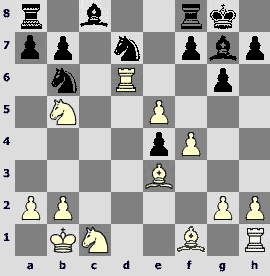
A picturesque position. Black has practically nothing to move with. Bad is17...¦e8? because of 18.¤c7, and 17...¦d8 meets with 18.¤xa7!. During the game there followed
17...ўh8 18.a4! ¦b8. If 18...¤xa4, then 19.¤c7 ¦b8 20.Ґxa7.
19.¤xa7 1-0
We can only sympathize with sad fate of the opponent's pieces. I can't refrain from drawing parallels: here are two more examples showing, how much the play based on the restriction of the opponent's pieces mobility is inherent in the Vladimir's style.
Kramnik – Lputian
Dortmund 1992
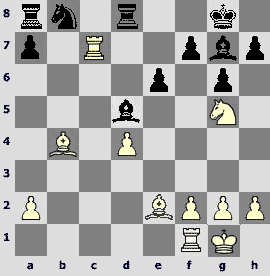
19.Ґb5! Now Black cannot finish the development of his Q-side without losing material.
19...a6 20.Ґa4! The threat Ґe7 is more terrible than its execution itself: 20.Ґe7? axb5 21.Ґxd8 ¤c6.
20...a5 21.Ґe7 ¤a6 22.Ґxd8 ¦xd8 23.¦a7 Ґc4 24.¤xf7 Ґxd4 25.¤xd8 Ґxa7 26.¦c1 Ґxa2 27.¦c8 Ґb6 28.¤b7+, and Black resigned in view of 29.¦с6.1-0
Kramnik – Karpov
Dos Hermanas 1997
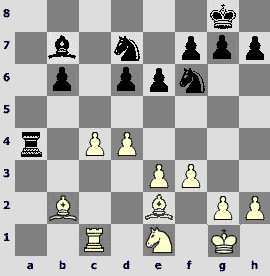
23.Ґd1! After 23.¦a1 ¦xa1 24.Ґxa1 Ґa6 the game would have been much easier for Black.
23...¦a2 24.¤d3 ўf8 25.Ґb3 ¦a8 26.e4 ¤b8 27.c5 bxc5 28.dxc5 dxc5 29.¤xc5 Ґc8 30.e5! ¤e8? A decisive mistake. Black should have agreed to a worse ending after 30...¤d5 31.Ґxd5 exd5.
31.Ґa4!
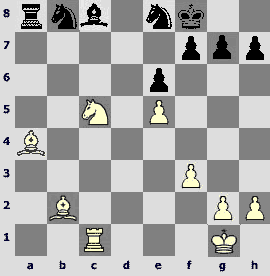
So once again we can see that Kramnik's opponent is driven into a corner. It is impossible to get free from such a vice. Threatens both 32.Ґa3 and the rook' transfer to d8.
31...¤c7 32.Ґa3 ўg8 33.¤e4! ¦xa4. Or 33...¤ba6 34.Ґd6 ¦a7 35.Ґb5 followed by 36.Ґxa6.
34.¦xc7 Ґa6. Not helpful either is 34...Ґd7 35.Ґd6 ¦a1+ 36.ўf2 ¦b1 37.¤c5 gaining a piece.
35.¤c5! Black resigned, as the material losses are unavoidable.1-0
Kramnik was never daunted by complications as well, facing the future with confidence. The following game played in a sharp offensive style had once impressed me greatly. Exactly after it the name Kramnik became associated with "big-time" chess.
Brodsky – Kramnik B33
Kherson 1991
1.e4 c5 2.¤f3 ¤c6 3.d4 cxd4 4.¤xd4 ¤f6 5.¤c3 e5. Cheliabinsk Variation has remained Kramnik's faithful weapon to this day.
6.¤db5 d6 7.Ґg5 a6 8.¤a3 b5 9.Ґxf6 gxf6 10.¤d5 f5 11.Ґd3 Ґe6 12.Јh5 ¦g8 13.O-O-O A rare continuation in comparison with 13.g3 and 13.c3.
13...¦xg2 14.f4? White is in the resolute mood, but such kind of a play in given position is not justified, so Kramnik begins the decisive counterattack. Safer is 14.Јf3!

14...¤d4!15.¤e3. If 15.c3, then 15...Ґxd5 16.exd5 b4!µ.
15...¦f2 16.exf5. An attempt to exchange the active rook by way of 16.¦hf1!? would not allow to solve the problems because of 16...¦xf1 17.¦xf1 ¦c8µ.
16...Ґxa2 17.fxe5. After 17.¤g4 ¦c8! There is a threat of 18...¤b3#.
17...dxe5 18.¤xb5. White seems to have some aces up his sleeve as well, but Vladimir has provided for every eventuality.
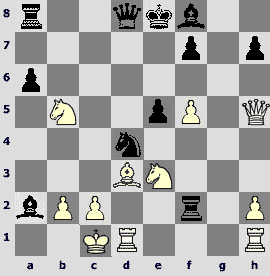
18...Ґh6!! A crucial move. To an unclear play leads18...axb5 19.Ґxb5+ ¤xb5 20.¦xd8+ ¦xd8 21.f6!›.
19.¦he1. A nice ending arises in case of 19.Јxh6 ¦xc2+! 20.Ґxc2 (20.¤xc2 ¤b3#) 20...¤e2#.
19...axb5 20.Ґxb5+. Hopeless is 20.Јxh6 Ґc4 21.b4 ¦a1+ 22.ўb2 ¦a2+ 23.ўb1 Јa8°.
20...ўe7 21.Јh4+. 21.Јxh6 ¦xc2+!°;21.f6+ ¦xf6 22.Јxe5+ ¦e6 23.Јc5+ Јd6°.
21...f6 22.Јxf2 Ґf7. Now the black attack is irrefutable.
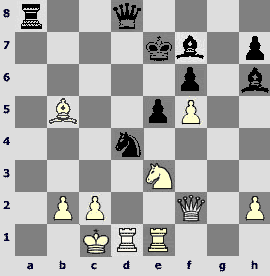
23.Ґd3. Or 23.b3 Јa5 24.Ґa4 Јc3! 25.¦d3 ¤xb3+ 26.ўd1 Ґh5+!
23...Јb6 24.Ґe4 ¦a2 25.c4 Ґxc4 26.ўb1 Јa5 27.¤d5+. If 27.¤c2, then 27...¦a1+, and there is a mate on the next move.
27...Ґxd5 28.Јxd4 ¦a1+ 29.ўc2 ¦xd1 30.Јxd1 Јa4+ 31.ўc3, and White resigned without waiting for 31...Јc4#. 0-1
So where is the real Kramnik? Is he a merciless boa constrictor, tightening a noose around his opponent's neck and creating positional masterpieces, resembling the "immortal zugzwang game" Saemisch – Nimzowitsch, or a destructive hurricane, sweeping off everything in his way in his offensive gust resulting from some seemingly insignificant mistake of his opponent's? The trick is that he is both. A keen positional sense and inborn intuition had been suggesting to Vladimir what kind of chess he was to play. On the early stage of his creative career Kramnik used to find pleasure in playing any kind of a position. It was exactly his universality that later allowed him to achieve his greatest successes.
Kasparov's suggestion to insert the young and unseasoned player in the Russian National team lineup for 1992 Olympiad in Manila had been a surprise for many, but the result shown (8.5 points out of 9!) abashed the skeptics. Vladimir's brilliant performance actually gave him a pass into a chess elite. Among all the games played by Kramnilk during this most significant tournament the following one appears to be the most typical for his creative style on the whole.
Kramnilk – Lanka E81
Manila 1992
1.d4 ¤f6 2.c4 g6 3.¤c3 Ґg7 4.e4 d6 5.f3 O-O 6.Ґe3 ¤bd7 7.Јd2 c5 8.d5 ¤e5 9.Ґg5 ¤fd7 10.Ґh6N Ґxh6 11.Јxh6 a6?! It was necessary to look for counterplay by way of 11...f5!

12.h4! f6. Or else there follows h4-h5.
13.Јd2 Јa5 14.f4 ¤f7 15.¤f3 ¦b8 16.a4. Black does not seem to have blundered anywhere, but his position is a sorry sight. Kramnik has made his habitual prophylactic work and soon will get to utilizing his advantage in the center.
16...¤b6 17.Ґd3 Ґg4. On 17...Јb4 White will simply answer 18.b3, and the pawn is untouchable.
18.¤h2 Ґd7 19.b3 ўh8 20.O-O ¤a8 21.Јb2 ¦g8 22.¤f3 Ґg4
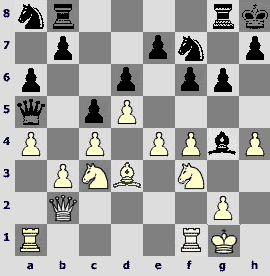
23.e5! Everything ingenious is simple indeed. All White needs to win is only accuracy in calculating some not very complex variations.
23...Ґxf3. A preliminary capture on e5 would hardly change anything.
24.exf6! Ґg4 25.fxe7 ¦g7 26.¤e4 ¤c7 27.¤f6 Ґh5. If 27...¤h6, then 28.¦ae1 ¤e8 29.¤xg4 ¤xg4 30.f5! ¤e5 (30...gxf5 31.Ґxf5 ¤e5 32.¦xe5 dxe5 33.Ґe6ќ) 31.¦xe5! (but not 31.fxg6? Јxe1! 32.¦xe1 ¤xd3) 31...dxe5 32.Јxe5 Јc7 33.Јxc7 ¤xc7 34.f6 ¦f7 35.d6, and the pawns queen.
28.¦ae1 ¤e8
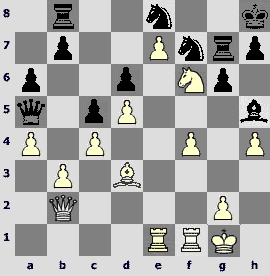
29.¤d7! ¦a8 30.f5 g5 31.hxg5 ¤xg5 32.f6 ¦f7. Useless is 32...¤f3+ 33.ўh1 ¤xf6 34.¤xf6 ¤xe1 35.¤xh5.
33.Ґf5 ¤c7 34.¤f8! Preventing the rook from getting on g8 and depriving the opponent of his last chance.
34...h6 35.¦e3 b5 36.g4 bxc4 37.gxh5 c3 38.¦xc3 ¤xd5 39.¦d3 c4 40.bxc4 Јc5+ 41.Јd4 Јxd4+ 42.¦xd4 ¤e3 43.Ґg6 ўg8 44.¦xd6 1-0
The Manila triumph was corroborated by the excellent play in the European Team championship.
Kveinys – Kramnik B66
Debrecen 1992
1.e4 c5 2.¤f3 d6 3.d4 cxd4 4.¤xd4 ¤f6 5.¤c3 ¤c6. This scheme as well as the Cheliabinsk variation was a solid part of Kramnik's opening repertoire.
6.Ґg5 e6 7.Јd2 a6 8.O-O-O h6 9.Ґf4 Ґd7 10.Ґg3 ¦c8 11.f3 ¤xd4 12.Јxd4 e5 13.Јe3 Ґe7 14.ўb1 O-O 15.h4 Јc7 16.Ґd3 Ґe6 17.Ґh2 Јa5 18.Јe1
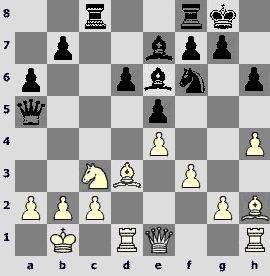
18...¦xc3! The sacrifice of an exchange is, of course, self-evident, but to anticipate the following course of events was not so very easy at all. To my mind, at the time Vladimir had to trust his intuition to a considerable extent.
19.Јxc3 Јxa2+ 20.ўc1 d5! A multipurpose move. Opening up the game Black includes all his minor pieces into play and also takes under his control the a3-square, preventing the white queen from getting there. For the sake of it Kramnik is ready to part with his central pawn.
21.Ґxe5. On 21.Јxe5 best of all is 21...Ґb4! 22.c3 ¦c8 23.Ґb1 Јa1 with dangerous threats.
21...dxe4 22.Ґxe4 ¤xe4 23.fxe4 ¦c8 24.Јg3!? Hastens the issue. But then after 24.Јd3 Ґg4! 25.Јg3 Јa1+ 26.ўd2 ¦d8+ 27.ўe3 (27.ўc3? ¦xd1 28.Јxg4 Јa5+ 29.ўb3 Јb4+ 30.ўa2 Јa4#) 27...¦xd1 28.Јxg4 Јc1+ 29.ўf3 Ґf8 things look equally bleak for White.
24...f6 25.Ґd4
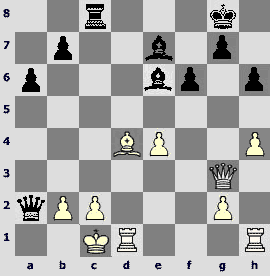
25...Ґb3! Black forcibly acquires queen against two rooks and a won position.
26.Ґc3 Јa1+ 27.ўd2 ¦d8+ 28.Јd3 ¦xd3+ 29.ўxd3 Ґxc2+ 30.ўxc2 Јa4+ 31.ўd3 b5 32.ўe3 Ґc5+ 33.ўf4 Јc4 34.¦d8+ ўh7 35.¦hd1 Јe2 36.ўf5 b4 37.Ґe1 Јxg2 38.e5 Јg6+ 39.ўe6 Јg4+ 40.ўf7 Јh5+ 0-1
In 1993 a series of elite tournaments has begun. Linares, of course, stands apart among them. During his debut tournament Vladimir had not still been ready to fight for the highest places, but even then he had already managed to show, how dangerous he was for any opponent.
Ivanchuk - Kramnik B57
Linares 1993
1.e4 c5 2.¤f3 ¤c6 3.d4 cxd4 4.¤xd4 ¤f6 5.¤c3 d6 6.Ґc4 Јb6 7.¤b3 e6 8.Ґf4 ¤e5 9.Ґe2 a6 10.Ґg3
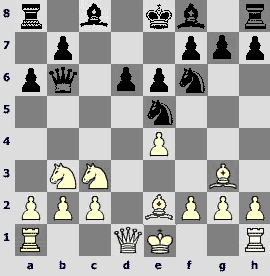
10...h5! "An intuitive and very strong move that can be called "a truly Sicilian one"; I was really glad with it" (Kramnik). Black king remains centralized, but Vladimir has counted on dynamic features of this position and turned out to be right.
11.h3. Not advantageous for White is 11.f4? ¤eg4, but 11.f3!? deserves attention.
11...Јc7 12.f4 ¤c4 13.Ґxc4. Would not do13.e5? dxe5 14.fxe5 ¤xe5 15.Јd4 ¤f3+. To the complex play leads13.Јd4 b5 14.e5 dxe5 15.fxe5 Ґb7 16.O-O ¦d8›.
13...Јxc4 14.Јf3 h4! 15.Ґh2 Ґd7 16.O-O-O ¦c8 17.¦he1 b5 18.Јf2? Ivanchuk is already pressed for time and starts making mistakes. Stronger is 18.a3.
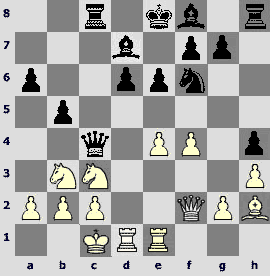
18...Јc7! An unexpected resource. Now it is too late to play19.a3 because of 19...a5.
19.e5. White has to force the events, but Black is ready for complications.
19...b4 20.¦d3. Advantageous for Black is 20.exf6 bxc3 21.f5 cxb2+ 22.ўb1 e5 23.fxg7 Ґxg7.
20...dxe5 21.fxe5 bxc3 22.¦xc3. On 22.exf6 Јxh2 23.¦xd7 there is an accurate retort 23...Јg3! with black advantage.
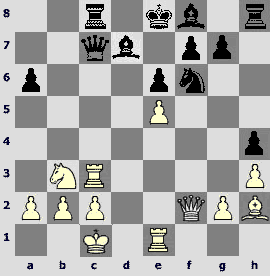
22...Јxc3. Black has powerful compensation for his queen. Another possibility is 22...Јb8, but in this case after 23.¦xc8+ Ґxc8 24.¦f1 it was really hard to find the "computeresque" 24...¦h7!
23.bxc3 Ґa3+ 24.ўd2? A decisive mistake. The only defense is 24.ўb1! ¤d5 25.Ґf4! (indicated by Anand).
24...¤d5 25.¦e4 ¦xc3 26.¦g4 O-O! K-side rook gets into a fight deciding the issue.
27.Јxh4 ¦fc8 28.¤d4 Ґb4 29.ўe2 Ґb5+ 30.¤xb5. Denying Black the pleasure of spectacularly finishing the game in the variation 30.ўf2 ¦xc2+ 31.¤xc2 ¦xc2+ 32.ўf3 (32.ўg1 ¦c1+ 33.ўf2 ¦f1+ 34.ўg3 Ґe1#) 32...Ґe2+ 33.ўe4 ¦c4#.
30...¦xc2+ 31.ўf3 axb5 32.¦xb4 ¤xb4 33.Јxb4 ¦8c3+ 0-1
And soon the qualification rounds of World championships of both versions (FIDE and PCA) had been successfully passed, and Vladimir Kramnik got the right to play in candidates matches. In my memory remained the nontrivial ending of the game against a strong English GM.
Kramnik – Speelman
Biel 1993

34.¦xc5!? Objectively speaking, White has nothing here, but still he tries to use his best chance.
34...¤xc5 35.¤xc7 ¦xa5 36.ўb4

36...¦xa4+?! After correct reply 36...¤a6+ 37.ўxa5 ¤xc7 38.ўb6 ¤e6 39.c7 ¦c8 40.¦c1 ўe7 41.ўb7 ўd7 42.¦d1+ ¤d4 43.¦c1 ¤e6 the game would have ended in a draw.
37.ўxc5 ¦a2 38.¤d5+ ўe6 39.¤c7+ ўf6 40.¤d5+ ўe6 41.¦c1. A strong centralized knight and a passed pawn guarantee more than enough compensation for an exchange to White.
41...¦c8? Vladimir's opponent makes his fatal mistake. On 41...¦xg2? there is 42.f4! f6 (42...g6 43.f5+) 43.f5+ ўf7 44.c7± , but 41...g6! still allows to retain chances for salvation.
42.c7 ¦xg2 43.ўc6 ¦xh2 44.ўb7 ¦xc7+ 45.¦xc7 f5 46.¦c6+ ўf7 47.exf5. Kramnik is precise in converting his extra pawn.
47...¦f2 48.¦c7+ ўg8 49.ўc6 ¦xf3 50.ўd6 e4 51.f6 e3. Capturing the last pawn 51...gxf6 leads to a mate after 52.ўe6.
52.¦xg7+ ўf8 53.¦e7 h5 54.¦xe3 1-0
Candidates matches of 1994 have not been successful for Vladimir, and this was a surprise for many. However, the beginning was not so bad at all. The match against Leonid Yudasin was won, although not without some adventures.
Yudasin – Kramnik
Wijk aan Zee 1994
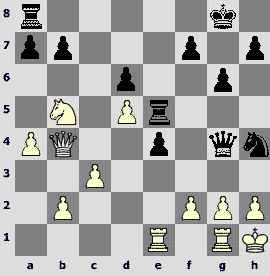
21...Јf4?! A risky decision. After 21...¤f3 22.gxf3 Јxf3+ 23.¦g2 e3 the complications ensue, in which all Black can claim to is perpetual check. There is also a move 21...¦ae8!?. Kramnik aspires for more, but his plan has been based on a miscalculation.
22.Јxd6?! A mistake in return. After 22.¤xd6! Black planned 22...¦h5? 23.¦xe4 ¤f3, missing a simple reply 24.¦e8+. After that Black would have to play 22...a5 23.¦xe4 ¦xe4 24.Јxe4 Јxd6 25.Јxh4 Јxd5 and fight for a draw.
22...¤f5 23.Јc7?! And here White should have played 23.Јb4.

23...e3! Now Black develops an irrefutable attack.
24.¦xe3 Јxe3! 25.¤d6. Naturally, on 25.fxe3 there follows 25...¤g3+! 26.hxg3 ¦h5#.
25...¦e7 26.¤xf5 gxf5 27.Јd6 Јe5 28.Јb4 ¦ae8 29.Јh4 f6 30.h3 Јxd5 0-1
But even in this victorious match some negative psychological moments were evident. Having acquired an early lead and indisputably outclassing his opponent, Kramnik did not try to make a breakaway but on the contrary refused to struggle at his full potential, especially while playing as White. As a result of it everything had been hanging by a thread until the last moment, and the victory did not look convincing. What was the reason of it? Maybe the opponent had failed to become a real irritant for Kramnik, and in such a situation Vladimir aimed to win on the cheap? At any rate, his following run of bad luck in the matches against Gelfand and Gata Kamsky was not an accident. It has shown that one has to prepare in a proper way for such high level competitions, psychological training not excluded.
As it often happens, defeats have played their beneficial part. They turned out to be a kind of run-up that allowed Vladimir to clear a new height. Since1995 Kramnik has become not just a chessplayer of the World Top Ten, but one of the main candidates for a victory in any tournament, including those in which Kasparov took part. On January 1,1996 Vladimir Kramnik's name occupied the top line in a regular FIDE rating-list.
On the whole the years from 1995 to 2000 in Kramnik's chess carrier can be regarded as a forerunner to its main event, which is still to be talked about. During this time Vladimir has taken part in many great competitions and played a lot of splendid games. I'd like to tell you about those ones that have stuck to my memory a little more firmly than the others, and at the same time reflect the different facets of Vladimir Kramnik's chess creative work.
Playing as Black he had preferred to be quite aggressive at the time. His readiness to take over the initiative and to punish his opponent for his incorrect game was evident. Naturally, Vladimir's opening repertoire was in line with his playing philosophy.
Even very strong GMs often fell victims to his headlong attacks. The following game was played during the Belgrade tournament that Vladimir won together with Gelfand. It has something in common with his game against Brodsky cited above.
Ljubojevic – Kramnik B33
Belgrade 1995
1.e4 c5 2.¤f3 ¤c6 3.d4 cxd4 4.¤xd4 ¤f6 5.¤c3 e5 6.¤db5 d6 7.Ґg5 a6 8.¤a3 b5 9.Ґxf6 gxf6 10.¤d5 Ґg7 11.g3 f5 12.exf5 e4 13.f6?! A tempting idea, which turns out to be not quite correct in the end.
13...Ґxf6 14.¤xf6+ Јxf6 15.Јd5
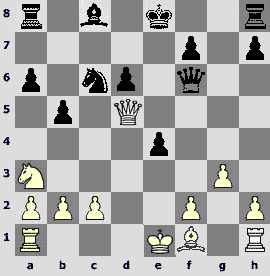
15...O-O! The punishment is not long in coming.
16.c3? White drifts with the tide, although it has been really hard to find out that there is nothing better here than 16.Јxc6 Јxb2 17.¦b1 Јxa3 18.Ґg2 Ґf5 19.O-O ¦ac8µ.
16...b4! 17.¤c4. On 17.Јxc6 follows17...bxa3 18.Јxa8 axb2 19.¦b1 Јxc3+ and 20...Ґg4+.
17...bxc3 18.Јxd6. Or 18.Јxc6 cxb2 19.¦b1 Јc3+ 20.¤d2 e3!°.
18...Ґe6! Every black piece is included into a fight, and it is time for White to resign. Queenside castling is a kind of agony.
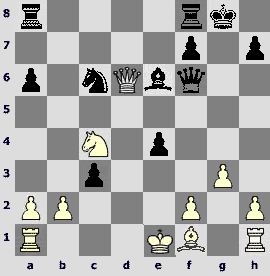
19.Јf4 Јg7 20.O-O-O ¤b4 21.Јe5 ¤xa2+ 22.ўb1 Јxe5 23.¤xe5 Ґb3! 0-1
Another fine "black Sicilian" is also kept in my memory. Opposite side castlings, a complex position...and lots of grounds for the opponent's mistakes. By the way, the game has been played in Dortmund, which is Vladimir's lucky city. He used to win the tournaments there confidently one year after another.
Huebner– Kramnik B66
Dortmund 1996
1.e4 c5 2.¤f3 d6 3.d4 cxd4 4.¤xd4 ¤f6 5.¤c3 ¤c6 6.Ґg5 e6 7.Јd2 a6 8.O-O-O h6 9.Ґe3 Ґe7 10.f4 ¤xd4 11.Ґxd4 b5 12.Ґd3 b4 13.¤e2 Јa5 14.ўb1 e5 15.Ґe3 O-O. The situation is routine enough, but here White begins to lose the game's guiding thread little by little.
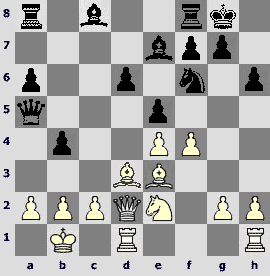
16.¦he1?! More preferable is 16.¦hf1 or 16.¤g3.
16...¦b8!? 17.¤c1 ¦d8. The d6-d5 advance is on the agenda.
18.Ґa7. An attempt to break the harmony in the black camp.
18...¦b7 19.Ґg1 Ґg4 20.¤b3 Јa4 21.¦c1 exf4. Premature is 21...¦b5?! because of 22.h3 Ґe6 23.f5 ¦a5 24.a3.
22.Јxf4 Ґe6 23.Ґd4? "An idea is OK, but the execution is all wrong. The dynamic equality was kept in case of 23.¦cd1 ¤g4 24.Ґd4. The opponent's reply has been a really unpleasant surprise for Huebner, and he began making one mistake after another" (Kramnik).
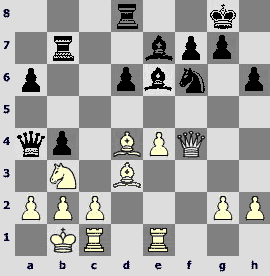
23...¦b5! 24.Јd2? Of course, in case of 24.Ґxb5 axb5 White cannot defend the a2-pawn, but he should have played 24.¦cd1!, vacating the square for the knight.
24...¤g4! On 24...¦a5 Huebner has up his sleeve 25.a3.
25.c4? White has some drawing chances only in the variation 25.Ґxb5 axb5 26.a3 bxa3 27.bxa3 (27.Јa5? axb2 28.Ґxb2 Ґxb3) 27...Ґg5 28.Јb4 Јxb4 29.axb4 Ґxc1 30.¦xc1 ¤xh2.
25...bxc3 26.bxc3. Any other reply could not have saved White as well: 26.Ґxb5 Јxb3!;26.Јxc3 ¦xb3 27.axb3 Ґxb326.¦xc3 Ґxb3 27.axb3 Јxd4.
26...¦xb3+ 27.axb3 Ґxb3. White resigned without waiting for another black rook to get on the b-file. 0-1
Vladimir's rivalry with Veselin Topalov has already begun in the middle of 1990th, and its course was favorable for Kramnik. In the following game Vladimir had chosen a principled variation, which resulted in a complex intricate position. This development was quite all right for Topalov who had always looked for such play, but in this particular case Vladimir was the one to untangle the complications better.
Topalov – Kramnik E07
Linares 1997
1.d4 d5 2.c4 c6 3.¤f3 ¤f6 4.¤c3 e6 5.g3 ¤bd7 6.Ґg2 dxc4 7.a4 Ґe7 8.O-O O-O 9.e4 e5 10.dxe5 ¤g4 11.Ґf4 Јa5 12.e6 fxe6 13.Јe2 ¤ge5 14.¤d4
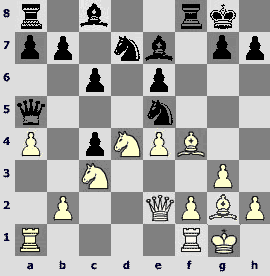
14...¤d3! A significant improvement, previously 14... ¤b6 was employed. Black is not willing to waste the time for defense of the e6-pawn, and this becomes the reason for the following complications.
15.¤xe6 ¦f6 16.Ґc7.After 16.¤c7 ¤xf4 17.Јxc4+ ўh8 18.¤xa8 ¤e5 19.Јb3 ¤xg2 20.ўxg2 ¤f3 Black has strongest initiative.
16...Јb4 17.¤d4 Ґc5! 18.¤c2 Јxb2 19.¤d1 Јb3 20.¤de3. Having sacrificed the b2-pawn, Topalov intends to advance his K-side pawns, but White is not fated to play f2-f4.
20...¤7e5 21.h3. Premature is 21.f4 in view of 21...Ґg4.
21...Ґe6 22.ўh2. And now on 22.f4 there is a very strong reply 22...¤b4! 23.ўh2 Јd3.
22...¦h6!? 23.¦ab1?! Variation 23.f4 ¤g4+ 24.¤xg4 Ґxg4 25.Јxg4 Јxc2 is also favorable for Black, but that is just the way to play.
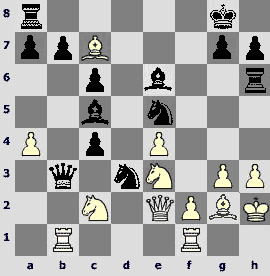
23...Ґg4! A fine counterstrike, which White has overlooked.
24.¤xg4. If 24.f3, then 24...¤xf3+ 25.Ґxf3 Ґxh3 with decisive threats.
24...¤xg4+ 25.Јxg4 Јxc2 26.Јg5
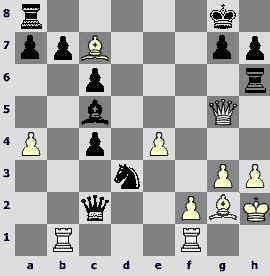
26...¤xf2! 27.¦xf2. Now it turns out that in case of 27.Јxc5 there follows 27...¦xh3+! 28.ўg1 (28.Ґxh3 ¤g4+ 29.ўg1 Јh2#) 28...¦h1+! 29.Ґxh1 ¤h3#.
27...Јxf2 28.¦f1 Јd4. Black has a considerable material advantage, and all the following moves are purely optional.
29.Ґe5 Јd7 30.Јc1 Јe6 31.Ґxg7 ўxg7 32.Јg5+ ¦g6 33.Јxc5 Јd6 0-1
The competition with Vishi Anand was also very significant for Vladimir. None of the worthy opponents gained any appreciable advantage in their games against each other, most of which had ended in a draw. To defeat the redoubtable "Madras tiger", one has to create a masterpiece.
Kramnik – Anand A15
Las Palmas 1996
1.¤f3 ¤f6 2.c4 b6 3.g3 Ґb7 4.Ґg2 e6 5.O-O Ґe7 6.¤c3 O-O 7.¦e1 d5 8.cxd5 ¤xd5 9.e4 ¤xc3 10.bxc3 c5 11.d4 ¤d7 12.Ґf4 cxd4 13.cxd4 ¤f6 14.¤e5 Ґb4 15.¦e3 ¦c8
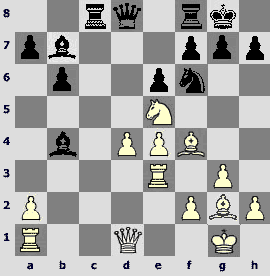
16.d5! A crucial decision. White stakes on the central passed pawn. It seems to me that exactly after this game such a pawn has acquired the name of a "Kramnik pawn".
16...exd5. No other reply promises Black a more or less comfortable play either, for instance 16...Ґc3 17.¤c6 Ґxc6 (17...¦xc6? 18.dxc6 Ґxa1 19.Јxd8 ¦xd8 20.cxb7ќ) 18.¦xc3 exd5 19.exd5 , and in case of 19...Ґxd5? 20.¦xc8 Јxc8 21.Ґxd5 ¦d8 22.¦c1! Black has no time to win back a piece.
17.exd5 Ґd6. It is important that on 17...¤xd5 18.¦d3 ¤xf4!? there follows 19.gxf4! Ґxg2 (19...Јc7 20.¦d7 ¦fd8 21.¦xc7 ¦xd1+ 22.¦xd1 ¦xc7 23.¦d8+ Ґf8 24.Ґxb7 ¦xb7 25.¤d7ќ) 20.¦xd8 ¦fxd8 21.Јb3 Ґc3 22.ўxg2! Ґxa1 23.¤xf7 ўf8 24.¤g5 ¦d7 25.Јe6 with a win in view of the threats 26.¤xh7# and 26.Јxd7.
18.¤c6 Ґxc6 19.Ґxd6 Ґa4!? The best chance.19...Јxd6 20.dxc6 Јxd1+ 21.¦xd1 ¦c7 22.f4± looks really sad for Black.
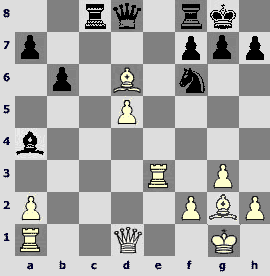
20.Ґxf8! The most precise way. 20.Јxa4 Јxd6 21.Јxa7 ¤xd5 22.Ґxd5 Јxd5 23.Јxb6 makes White's task more difficult.
20...Ґxd1 21.Ґe7 Јc7. Bad is 21...¤xd5? 22.Ґxd8 ¤xe3 23.Ґg5! ¤xg2 24.¦xd1ќ.
22.¦xd1 ¤d7. It is very dangerous to play 22...Јc2 23.¦ed3 Јxa2 24.Ґxf6 gxf6 25.d6 ¦d8 26.d7, and White will gradually prepare the transfer of the rook on c8 or e8.
23.Ґh3 h6 24.Ґf5 b5 25.Ґb4! ¦d8 26.¦e7 Јc4. On 26...g6 there goes 27.Ґe6! fxe6 28.dxe6 ¤f8 (28...Јc2 29.¦dxd7 ¦xd7 30.exd7 Јd1+ 31.ўg2 Јd5+ 32.f3 Јxa2+ 33.ўh3) 29.¦xc7 ¦xd1+ 30.ўg2 ¤xe6 31.¦xa7 with an easily won ending.

27.¦xd7! ¦xd7 28.Ґxd7 Јxb4 29.d6. Black is unable to stop the passed pawn.
29...Јa4 30.¦d3 Јe4 31.Ґxb5 Јe1+ 32.ўg2 Јe4+ 33.ўg1 Јe1+ 34.ўg2 Јe4+ 35.ўf1 Јh1+ 36.ўe2 Јe4+ 37.ўf1 Јh1+ 38.ўe2 Јe4+ 39.ўd1 Јg4+. Neither 39...Јb4 40.d7 Јb1+ 41.ўe2 Јxa2+ 42.ўf3 nor 39...Јh1+ 40.ўc2 Јa1 41.d7 Јxa2+ 42.ўd1 Јb1+ 43.ўe2 can save Black.
40.f3 Јh3 41.d7. After 41...Јf1+ 42.ўc2 Јe2+ 43.¦d2! the checks are over, so Black resigned. 1-0
Kramnik's victory in Dos Hermanas also remains in my memory. Being convincing and appropriate, it illustrates both Vladimir's strong and weak points though.
Kramnik – Anand D27
Dos Hermanas 1999
1.d4 d5 2.c4 dxc4 3.¤f3 e6 4.e3 ¤f6 5.Ґxc4 c5 6.O-O a6 7.Ґb3 cxd4 8.exd4 ¤c6 9.¤c3 Ґe7 10.¦e1 O-O 11.a3 ¤a5 12.Ґc2 b5

13.d5!? This idea belongs to Garry Kasparov.
13...¦e8. Kramnik was certainly well prepared for principled continuations 13... ¤xd5 and 13...exd5.
14.Ґg5 h6 15.Ґh4 ¤xd5 16.¤xd5 exd5. Bad is 16...Ґxh4? 17.Јd3! g6 (17...f5 18.¤xh4 Ґb7 19.¤xf5!) 18.¤xh4 exd5 (18...Јxh4 19.Јc3) 19.¤xg6ќ.
17.Јd3 g6 18.Јe3 Ґe6. After18...¤c6 19.Ґxe7 ¦xe7 20.Јxh6± White has a comfortable advantage.
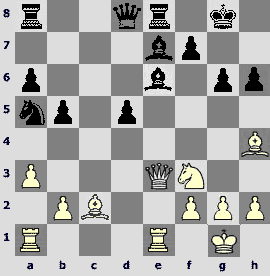
19.Јxh6!? Kramnik is not satisfied with 19.Ґxe7 Јxe7 20.Јxh6 with a small advantage, so he chooses the most ambitious course.
19...Ґxh4 20.Ґxg6! Јf6. The only move. Every other continuation leads to a rapid defeat: 20...Ґxf2+ 21.ўxf2 Јb6+ 22.ўf1 fxg6 23.Јxg6+ ўf8 24.¤g5 или 20...fxg6 21.Јxg6+ ўf8 22.Јh6+ ўf7 23.Јh7+ ўf6 (23...ўf8 24.¤xh4 Ґf7 25.Јh6+ ўg8 26.¤f5) 24.¤xh4 with an irrefutable attack.
21.Ґh7+ ўh8 22.Ґg6+ ўg8 23.Јh7+ ўf8 24.¤xh4
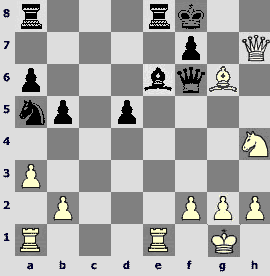
24...Јg7? On his own free will Black transposes the game into a difficult ending. After 24...Јxb2! 25.Ґd3 (25.¤f5 fxg6 26.Јh6+ ўf7 leads only to a draw) 25...Јg7 26.Јh5 ¤c4! White retains the initiative, but the position is objectively unclear.
25.Јxg7+ ўxg7 26.Ґd3 ¤c4 27.b4 ¤b2?! Not the best decision. Preferable is 27...d4.
28.Ґf1 d4 29.¤f3 ¦ad8 30.¦eb1 ¤c4 31.¦d1 Ґg4 32.¦d3! Anand has counted on 32.¦xd4 Ґxf3 33.¦xd8 ¦xd8 34.gxf3 ¤d2! with good drawing chances.
32...¤b2 33.¦xd4 Ґxf3 34.¦xd8 ¦xd8 35.gxf3 ¦c8

36.¦a2! Vladimir cashes in on badly standing b2-knight.
36...¤a4. If 36...¦c2, then 37.a4!
37.¦d2 ¦c6 38.f4 ¤b6 39.ўg2 ¤c4 40.¦d3 ¤b2. 40...¦g6+ 41.¦g3 ¤xa3 42.Ґd3 ¦xg3+ 43.fxg3 ¤c4 44.Ґxc4 bxc4 45.ўf3 leads to a lost pawn ending.
41.¦g3+ ўh8 42.Ґe2 ¦c2 43.Ґh5 ¦c7
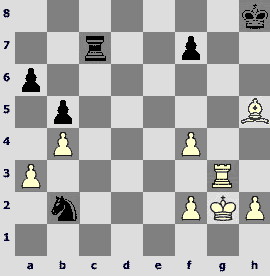
44.f5? Until this moment White has been irreproachable, but here comes the stage of relaxation and loss of concentration. Hence the inevitable mistakes, at least in the game against such a tenacious and resourceful player as Vishi Anand. Kramnik should have centralized his king by way of 44.ўf3.
44...ўh7 45.Ґe2. After 45.f6!? ўh6 46.Ґf3 ¤d3 47.h4 ¤f4+ 48.ўh2 ¤h5 49.¦g5 ¤xf6 50.¦c5 White has had every chance to win. Now the game is practically forcibly transposed into an ending with a bishop and two pawns against a knight and a pawn, which, however, is still won for White.
45...ўh6 46.h4 ¦c2 47.Ґf3 ¤c4 48.Ґd5. Having already touched the bishop Vladimir noticed that on 48.Ґb7 there follows 48...¤d6!, and it is impossible to play 49.Ґxa6? ¦c6.
48...¤d6 49.¦d3 ўg7 50.Ґf3! ¤xf5 51.Ґb7 ¤xh4+ 52.ўg1 ¦e2 53.Ґxa6 ¦e5 54.¦c3 ¤f5 55.¦c5 ¦xc5 56.bxc5 ¤d4 57.c6 ¤xc6 58.Ґxb5 ¤a5
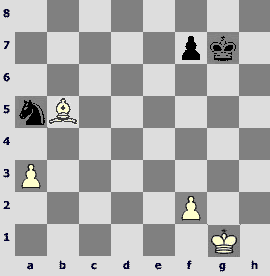
59.ўg2. On the final stage Kramnik demonstrates his fine technique and brings the game to a win confidently.
59...ўf6 60.ўf3 ўe5 61.ўe3 ¤b7 62.Ґc4 f6. Of course the pawn should not be moved to a light-colored square: 62...f5? 63.f4+ ўd6 64.Ґd3 ўe6 65.ўd4.
63.a4 ¤a5 64.Ґf7! In order to have an opportunity to defend the a4-pawn from the e8-square, for example: 64...ўd6 65.ўe4 ўc5 66.ўf5 ўb4 67.Ґe8.
64...¤c6 65.ўd3! ўd6. After 65...¤a5 66.ўc3 ўf4 67.Ґe8! ўf3 68.ўb4 Black loses the knight.
66.ўe4 ¤e7. Of no great help is also 66...¤a5 67.Ґd5! ўc5 68.f3! ўb4 (68...ўd6 69.ўd4 f5 70.f4) 69.ўf5 ўxa4 70.ўxf6 ўb5 71.f4 ўc5 72.ўe6, and the pawn queens freely.
67.a5 ўc5 68.a6 ¤c8. In case of 68...ўb6 69.Ґc4 ўa7 white king follows the route f4-g4-h5-h6-g7.
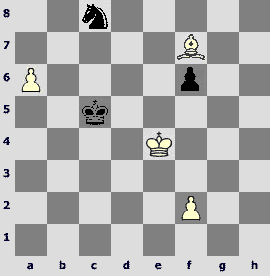
69.Ґh5! ўd6. Or 69...¤d6+ 70.ўf4 ўb6 71.Ґe2 ўa7 72.Ґd3 ўb6 73.ўg4 ўa7 74.ўh5.
70.Ґf3! Black resigned, as he is helpless to prevent his opponent's king breakthrough: 70...ўc6 71.ўf5+ ўb6 72.Ґb7 or 70...¤a7 71.ўd4 ¤b5+ 72.ўc4 ¤a7 73.Ґb7 ўc7 74.ўc5 f5 75.f4 ўb8 76.ўb6. 1-0
It is interesting to notice that for all his chess power Kramnik has still lacked stability. There was a constant impression that he would have been always able to play better but felt no particular necessity to do that. This irregularity was noticeable even in the course of one single game.
Kramnik – Short
Horgen 1995
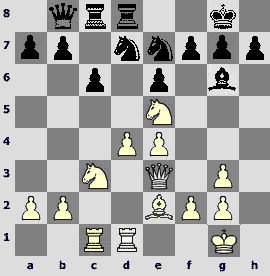
22.f4! Typical Kramnik's play: a positional clamp over the whole board.
22...b5?! Comparatively better is 22...¤xe5, but then 23.dxe5, and White is able to carry out g3-g4.
23.b4. The same strategy continued.
23...a5 24.a3 axb4 25.axb4 f6 26.¤xg6?! Considering spatial advantage more logical looks 26.¤d3.
26...hxg6
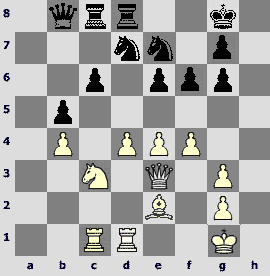
27.d5. Breakthrough in the center is Vladimir's trademark.
27...exd5 28.exd5 ¤f5? The queens should have been removed from the board promptly by way of 28...Јb6!
29.Јf2 c5. Short tries to ransom himself with a pawn, but the pay-off is too small.
30.¤xb5 ¤d6
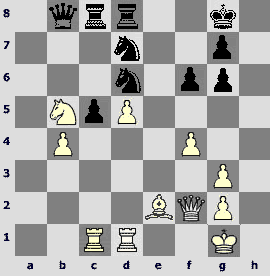
31.bxc5! Tactics serving strategy.
31...¤xb5 32.c6. It is clear that Black cannot keep his piece.
32...¤d6 33.cxd7 ¦xc1 34.¦xc1 ¦xd7 35.Ґd3 ўf7 36.¦c6 Јb3 37.Јf3 Јb7
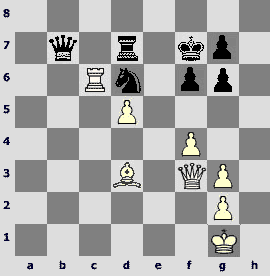
38.Јe3?! A transposition into an ending with extra pawn is a natural decision for Kramnik, all the more so because he has been pressed for time. A much shorter way to the goal is 38.Јe2! ¦e7 39.Јg4! f5 40.Ґxf5! etc.
38...¦e7 39.Јb6 Јxb6+ 40.¦xb6 ¦d7 41.ўf2 ¤c8 42.¦b8 ¤d6 43.¦b6 ¤c8 44.¦c6 ¤e7 45.Ґc4! ўf8 46.¦c5 ¦d8 47.¦a5 ¤f5 48.Ґd3 ¤e7 49.Ґe4 ўf7 50.ўe3 ¦d7

51.¦c5? After this move Black's chances for survival become real. White should have constricted the e7-knight with 51.g4!
51...¤f5+! 52.ўf2 ¦a7 53.g4 ¤d6 54.Ґc2 f5 55.¦c6 ўe7 56.gxf5 gxf5 57.ўe3 ¦a3+ 58.Ґd3 ўd7 59.ўd4 ¦a1?! 60.Ґc2 ¦f1?! The opponent lends a helping hand just in time with this unfortunate rook's maneuver. Better is 60...g6.
61.¦a6. The f4-pawn is untouchable, and White occupies the important a-file.
61...¦f2 62.¦a7+ ўe8 63.Ґa4+ ўf8 64.g3 ¦f3 65.¦d7 ¤f7 66.¦c7
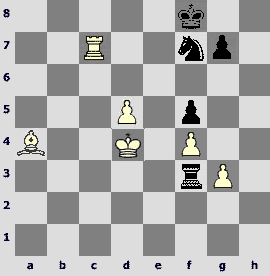
66...¦xg3?Loses instantly. It was necessary to play 66...¤d6.
67.¦c8+ 1-0
In this way Vladimir used to amuse himself with his opponents like a cat with a mouse, giving them chances in practically won positions and then outplaying them again. More often than not it worked, but sometimes the fun had ended in a loss of a point.
After such a long game (and there are lots of those in Kramnik's career) I would like to show by contrast a sparkling miniature played against the seasoned chess fighter Alexander Beliavsky. Here we come across a breakthrough in the center again, but it happens in the least expected moment.
Kramnik – Beliavsky A07
Belgrade 1995
1.¤f3 d5 2.g3 c6 3.Ґg2 Ґg4 4.O-O ¤d7 5.d4 e6 6.¤bd2 f5 7.c4 Ґd6 8.Јb3 ¦b8 9.¦e1 ¤h6 10.cxd5 cxd5 11.h3! Ґh5
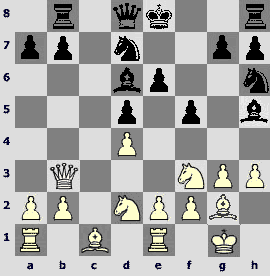
12.e4!! One can't help admiring this blow on the most defended point. Black needed only a tempo to castle.
12...fxe4 13.¤g5! Ґf7. If 13...Јe7, then 14.¤xe6! Ґf7 (14...Јxe6 15.¦xe4!ќ) 15.¤xg7+ ўf8 16.¤xe4 ўxg7 (16...dxe4 17.Ґxh6 Ґxb3 18.¤f5+ќ) 17.Ґg5 Јf8 18.Ґxh6+ ўxh6 19.Јe3+ ўg7 20.Јg5+ Ґg6 21.¤xd6 Јxd6 22.¦e7+ ўf8 23.¦ae1ќ, and on13...Јxg5 there follows 14.¤xe4 Јe7 15.Ґg5! ¤f6 (15...Јf8 16.Јxd5! exd5 17.¤xd6#) 16.¤xf6+ gxf6 17.Ґxh6±.
14.¤dxe4! dxe4 15.¤xe6 Ґxe6. Of no help is also15...Јf6 16.¦xe4 with irrefutable threats.
16.Јxe6+ Јe7 17.¦xe4! ўd8. In case of 17...Јxe6 18.¦xe6+ Ґe7 19.Ґg5 White wins back a piece and gets a won position.
18.Јd5. Black resigned, as after18...¤f6 19.¦xe7 ¤xd5 20.¦e6 all resistance is meaningless.1-0
And now let us pass on to the "purely positional" wins. In Vladimir's creative works there are a lot of games during which he played so simply and clearly, that they need practically no comments. A similar feeling of easiness and naturalness grasps you when you study the games of Jose Raul Capablanca, Vassily Smyslov and Anatoly Karpov. Kramnik follows in the footsteps of those great intuitive champions, although it is not easy at all to play this way in modern computer chess that are saturated to the hilt with dynamics and calculation play.
The following game is a triumph of White's light-square strategy.
Kramnik – Polgar E97
Vienna 1996
1.¤f3 ¤f6 2.c4 g6 3.¤c3 Ґg7 4.e4 d6 5.d4 O-O 6.Ґe2 e5 7.O-O ¤c6 8.d5 ¤e7 9.b4. Kramnik's pet weapon tested on many "Old Indians".
9...¤h5 10.¦e1 f5 11.¤g5 ¤f6 12.Ґf3 ўh8 13.Ґb2 a5
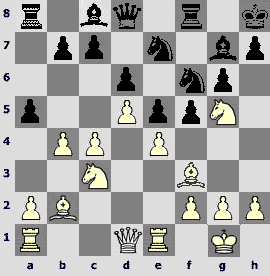
14.b5. The light-square strategy in effect. From this moment on we can watch Black being systematically deprived of any counterplay.
14...¦b8!? 15.¤e6 Ґxe6 16.dxe6 ¤e8 17.Јb3 c5. After 17...Јc8?! 18.c5 dxc5 19.¦ad1 ¤d6 20.b6! black position instantly becomes critical.
18.exf5 gxf5 19.Ґh5 ¤c7 20.Ґf7 Јc8 21.¤d5 ¤cxd5 22.cxd5
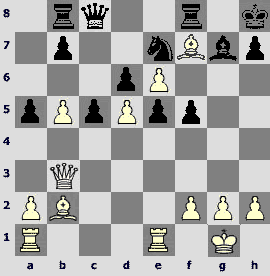
22...f4? Black already has perceptible difficulties in breathing. Here "a must" was 22...¦xf7 23.exf7 Јf8 with hopes of creating defense.
23.Ґh5! b6 24.¦ad1 ¦f5 25.Ґf3 Јg8 26.Ґe4 ¦g5 27.¦d3! Major pieces rush to the h-file.
27...Ґf6 28.¦h3 ¤g6
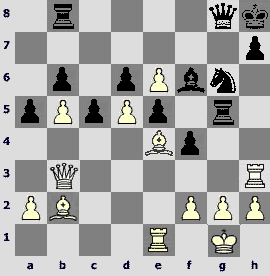
29.Јf3! A very strong decision. "Strange as it seems, White has to exchange his active rook in order to prevent black major pieces from tripling on the g-file, which could have given Black a kind of counterplay. After it the outcome of the game is prejudged" (Kramnik).
29...¦b7 30.¦h5 ¦xh5 31.Јxh5 ¦g7 32.g3 ¤e7 33.ўh1 Јf8 34.¦g1 ¤g8 35.Јf3 Ґg5 36.h4 Ґf6. If 36...Ґe7, then 37.gxf4, and on 36...Ґh6 there follows 37.g4.
37.¦g2 Јe7. Or 37...¤e7 38.gxf4 ¦xg2 39.fxe5!
38.Јh5! fxg3?! Hastens the outcome, although after 38...Јf8 39.g4 Јd8 40.g5 Black also fails to hold his ground.
39.fxg3 Јf8 40.¦f2 Јd8 41.g4! Ґe7 42.g5 c4 43.¦f7 Јe8 44.Јxh7+! Black resigned.
1-0
One of the strongest points of Kramnik's play is his fine endgame technique. Vladimir hardly ever refuses the transposition into an endgame with an advantage, even if he faces its long and laborious convertion. Quite possibly that a certain part here play his relations with Mikhail Botvinnik, who has always stuck to this strategy.
Adams – Kramnik B70
Wijk aan Zee 1998
1.e4 c5 2.¤f3 ¤c6 3.¤c3 d6 4.d4 cxd4 5.¤xd4 ¤f6 6.g3 g6 7.Ґg2 ¤xd4 8.Јxd4 Ґg7 9.O-OO-O 10.Јb4 a5 11.Јb3 Ґe6
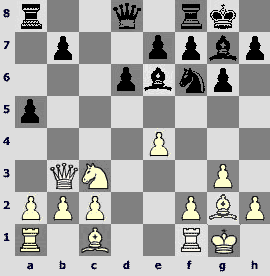
12.¤d5. It is a common knowledge that after 12.Јxb7?! Ґc4 or 12...¤d7 Black has sufficient compensation for the pawn. Michael Adams tries another, seemingly more secure way, dreaming of a draw at heart.
12...a4! 13.Јxb7 ¤xd5 14.exd5 Ґf5 15.Ґg5
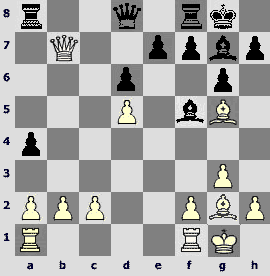
15...Јb8!? Black has had choices (15...a3!?, 15...Јa5!?), but Vladimir intends to make the situation clear.
16.Јxb8 ¦fxb8 17.Ґxe7 ¦xb2 18.a3. If 18.Ґxd6, then Black takes on c2 and later on a2 also.
18...¦xc2 19.¦ae1 ¦a6. The ending seems rather simple, but there are serious pitfalls for White in it.
20.Ґe4 Ґxe4 21.¦xe4 Ґb2 22.¦fe1? A fatal mistake. After 22.¦e3 White could have hoped for a draw still.
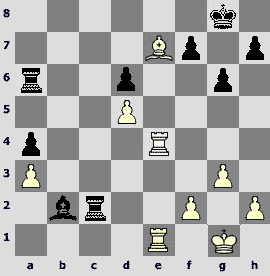
22...¦c1!The exchange of two rooks robs White of his illusions of getting a counterplay, and the passed a-pawn brings victory to Black.
23.¦xc1 Ґxc1 24.Ґf6 ¦a8 25.¦c4 Ґxa3 26.Ґd4 Ґc5! 27.Ґxc5 dxc5 28.¦xc5 a3 29.¦c1 a2 0-1
Lautier – Kramnik E58
Tilburg 1997
1.d4 ¤f6 2.c4 e6 3.¤c3 Ґb4 4.e3 O-O 5.Ґd3 c5 6.¤f3 d5 7.O-O ¤c6 8.a3 Ґxc3 9.bxc3 Јc7 10.cxd5 exd5 11.¤h4 Јa5 12.Ґb2 ¦e8 13.¦e1 c4 14.Ґc2 ¤e4 15.¦c1 Јd8 16.g3
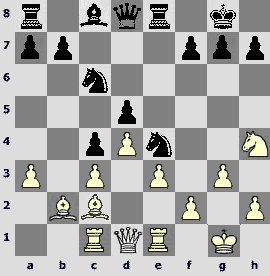
16...g5! The struggle for initiative demands firm actions, although all this is in fact prophylactics. If f2-f3 were allowed, then White would have an advantage.
17.¤g2 g4 18.f3?! Lautier probably fails to sense dangers threatening him in case of opening up the game.
18...¤g5! 19.fxg4 ¤h3+ 20.ўf1 Јg5 21.¤f4 Ґxg4 22.Јd2 Ґf5! Kramnik carries out the advantageous light-squared bishops exchange, after which Black's positional advantage is evident.
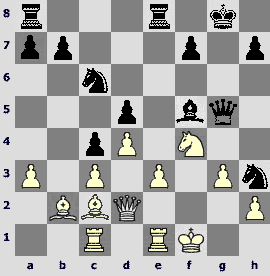
23.Јg2?! The lesser of two evils is 23.Ґd1.
23...¤xf4 24.gxf4. Now this move permits Vladimir to demonstrate his pet method of transposing the game into an advantageous ending once again. But 24.exf4 Јg6µ is no better anyway.
24...Јxg2+ 25.ўxg2 Ґxc2 26.¦xc2 f5. All the following Black actions need practically no comments – the king gets centralized, and then Vladimir prepares an invasion along the open g-line.
27.ўf3 ўf7 28.a4 ¦g8 29.Ґa3 ўe6 30.¦b1 b6 31.Ґb4 ¦ab8 32.¦cb2 ¦b7 33.¦g2 ¦xg2 34.ўxg2 ¦g7+ 35.ўf3 ¦g8 36.¦a1 h5 37.¦b1 h4 38.a5. The opponent looks for active counterplay, but it is already too late to change anything.
38...bxa5 39.Ґc5 ¦g7 40.Ґa3 h3 41.¦b5
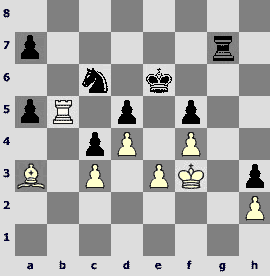
41...a4! The last nuance. Hasty 41...¦g2? 42.¦c5 ¤b8 43.¦c8 serves to lose an advantage.
42.¦c5 ¤b8 43.¦a5 a6 44.¦xa4 ¦g2. Now White is defenseless.
45.Ґb4 ¦xh2 46.ўg3 ¦e2 47.ўxh3 ¦xe3+ 48.ўg2 ¤c6 49.¦xa6 ўd7 50.ўf2 ¦d3 51.Ґc5 ¦xc3 52.¦b6 ¦b3 53.¦a6 ¦d3. The d4-pawn is doomed, so White resigned. 0-1
One thing Vladimir Kramnik can do better than probably every other member of the chess elite is to squeeze out minimal advantage in dry, tiresome and at first sight hopeless endings. And I mean not only an ability but a wish to do that as well.
Let us watch Vladimir finely winning a minor pieces ending against an experienced Spanish GM, who would later become Kramnik's second in many an important competition.
Kramnik – Illescas A17
Dos Hermanas 1997
1.¤f3 ¤f6 2.c4 e6 3.¤c3 Ґb4 4.Јc2 O-O 5.a3 Ґxc3 6.Јxc3 b6 7.g3 Ґb7 8.Ґg2 c5 9.b4 d6 10.O-O ¤bd7 11.Ґb2 Јe7 12.d3 ¦fc8 13.b5 a6 14.a4 axb5 15.axb5 Јf8 16.e4 ¦xa1 17.¦xa1 ¦a8 18.Јc1 ¦xa1 19.Јxa1 Јa8 20.Јxa8+ Ґxa8.

It seems that Black should not lose. To utilize a pair of bishops in such a position is very difficult. So it remains only to enjoy Vladimir Kramnik's art of utilizing the almost imperceptible positional nuances.
21.¤d2! Knight leaves for a4 in order to tie his opponent's hands with the defense of the b6-pawn.
21...¤e8 22.¤b1! Ґb7 23.f4 f6 24.¤c3 ўf7 25.¤a4 ўe7
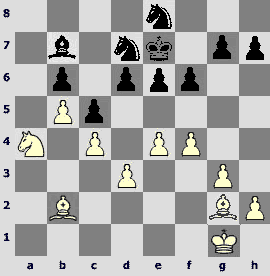
26.d4! An important part of the plan. White clamps the opponent on the Q-side as much as possible and then transfers the burden of struggle to the other flank. Another important point is that Black cannot play 26...cxd4 with subsequent capture of the c5-square with white knight standing on a4.
26...ўd8 27.d5! exd5. Bad is 27...e5? in view of 28.Ґh3.
28.exd5 ¤c7 29.Ґh3 ¤a8. Can you see any other way?
30.Ґe6 ¤f8 31.f5. White's achievements are seen with the naked eye.

31...Ґc8 32.ўf2 Ґd7 33.g4 ўe7 34.g5. It is impossible to avoid the weakness on the K-side.
34...¤xe6 35.fxe6 Ґe8
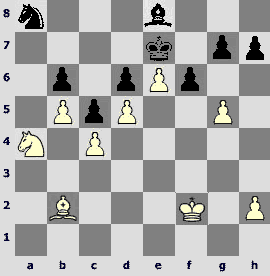
36.gxf6+?! Under time pressure Vladimir commits an inaccuracy, complicating his task. Better is 36.ўe3ќ.
36...gxf6 37.ўe3 Ґg6 38.ўd2 Ґe4 39.Ґc1. From this moment on the white pieces smoothly overflow to another half of the chessboard.
39...Ґg2 40.ўc3 Ґf1 41.Ґh6 Ґg2 42.Ґf4 Ґf1 43.¤b2 ¤c7 44.¤d1 Ґg2 45.¤e3 Ґe4 46.Ґh6 ¤e8 47.ўd2 ¤c7 48.ўe2 ¤e8 49.ўf2 ¤c7 50.ўg3 Ґd3 51.ўg4 ¤e8
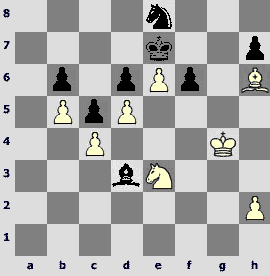
52.ўf4! Zugzwang comes to the rescue.
52...Ґb1 53.¤f5+ ўd8 54.Ґf8 Ґd3 55.Ґe7+ ўc7 56.¤e3 ўc8 57.ўg4 ўc7? The insertion of 57...Ґe2+ would have made the implementation of the white plan more difficult.
58.ўh5 ¤g7+ 59.ўh6 ¤e8 60.h4 ўc8 61.h5 ўc7 62.¤g2 ўc8 63.¤f4 Ґc2. It seems that Black has managed to build an impregnable fortress, but White's resources are far from being over.
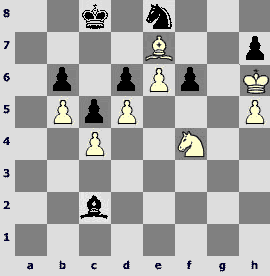
64.Ґxf6?! As Kramnik has indicated, much simpler way to win is 64.¤g6! hxg6 65.hxg6 Ґd3 66.g7 ¤xg7 67.ўxg7 Ґxc4 68.Ґxd6 Ґxb5 69.ўf8ќ.
64...¤xf6 65.ўg7 ¤e8+ 66.ўf7 ¤c7. If 66...ўd8, then White would have to find a study-like 67.e7+ ўd7 68.¤e6 Ґd1 69.¤f8+ ўc8 70.h6! Ґh5+ 71.ўg8 ¤f6+ 72.ўg7 ¤e8+ 73.ўxh7 Ґf7 74.ўh8 ўc7 75.¤e6+! ўd7 76.¤g7 ¤f6 77.¤f5 ¤e8 78.h7! Ґg6 79.ўg8 ¤f6+ 80.ўg7 Ґxh7 81.ўxf6ќ.
67.e7 h6 68.¤e6 Ґd1 69.ўg6. Such a cool-headed course of actions is really impressive taking into consideration the lack of a piece.
69...¤e8 70.¤f8 Ґe2 71.ўxh6 Ґxc4 72.ўg6
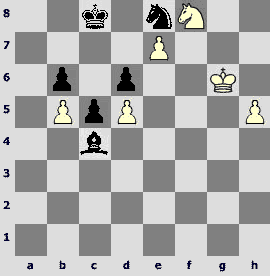
72...Ґxd5? No wonder that Black fails to withstand such a long siege. After 72...Ґd3+! 73.ўf7 c4 74.ўxe8 c3 75.ўf7 Ґxb5 76.h6 c2 77.h7 c1Ј 78.h8ЈЈf4+ 79.Јf6 Ґe8+ he retains practical chances for salvation.
73.h6. After that Black is unable to stop the passed pawns.
73...c4 74.h7 Ґe4+ 75.ўf7 Ґxh7 76.ўxe8 Ґg8 77.¤d7! 1-0
That is the way I see Vladimir Kramnik in the end of the last century – a super-skillful all-around player of classic school, who has been initiated into every secret of the chess art, knows everything about chess and is good at practically everything in the game. What did Vladimir lack? To my mind only a will to fight in every episode, a "killer instinct", a desire to outplay his opponent in every game at all costs, to squeeze himself dry for the sake of a win. "Playing against pieces" – that was the name that Svetozar Gligoric, a remarkable Yugoslav GM, had given to a collection of his best games. Vladimir Kramnik professes the same attitude towards chess.
In his creative works you can find excellent examples on the most various parts of chess strategy and tactics, but this is already the subject of the next part of our essay. And, of course, we will talk about his struggle with Garry Kasparov and about the kind of chess Kramnik plays in the 21st century. But now it's time for a breather...
